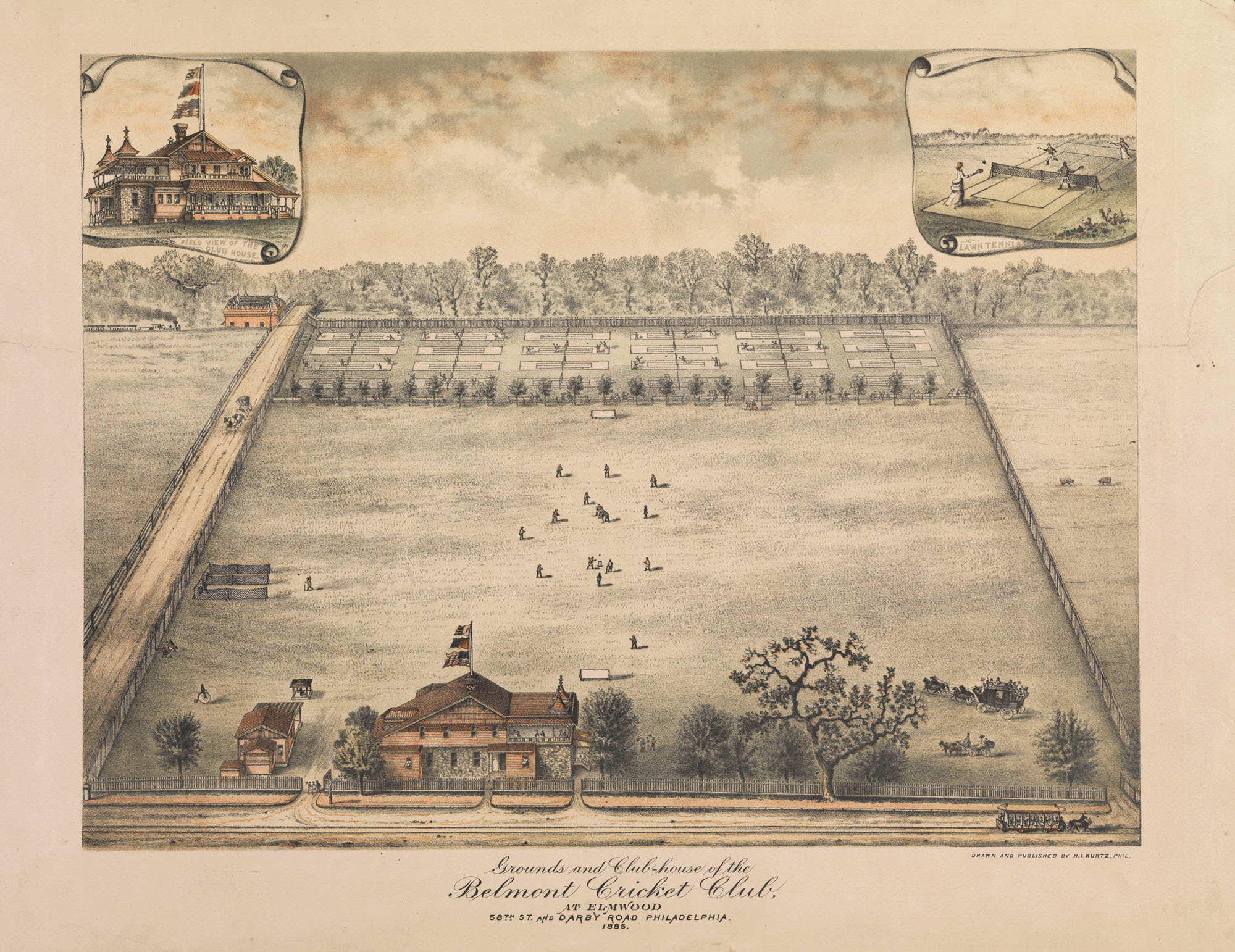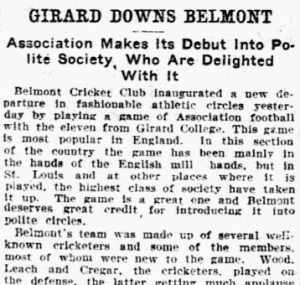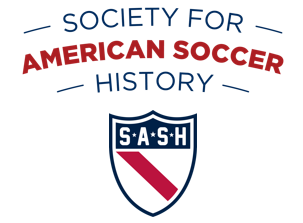
Tours by the English teams the Pilgrims (1905, 1909) and Corinthians (1906, 1911, and 1924) attracted significant press coverage and drew large crowds when they visited Philadelphia. The tours resulted in increased interest in soccer and helped to boost the formation of clubs and leagues in the Philadelphia area. But the first friendly between a Philadelphia team and an international team came several years before.
The cricket connection
As a major port city, it seems reasonable to expect the first soccer match in Philadelphia against an international side might have taken place against a team made up of crew members from one of the many ships from Britain that regularly docked in the city. Thus far, however, no records of such a match have been found. Instead, the first records of an international friendly in Philadelphia are found at Germantown Academy, the oldest nondenominational day school in the United States, which describes a match between players from the school and the “touring Bromhead Football Club of England” in 1877. Another account, a history of athletics at the school published in 1910, is less precise and says, “Sometime in the 70’s the Academy lost a game of Association Football to Bromhead’s English Team.” No contemporaneous newspaper reports of the match have been found. Personal correspondence with the National Football Museum in England has uncovered no records of a “touring” Bromhead club, although they were very interested to hear of the account.
The name Bromhead does have another Philadelphia connection, one from the world of cricket. For much of the second half of the Nineteenth Century, Philadelphia was the center of cricket in the United States (The Philadelphia Cricket Club, founded in 1854, is the oldest country club in the country) and host of numerous matches between Philadelphia teams and touring teams from around the British Commonwealth, the first from an English team in 1859. George Bromhead was born in England in 1856 and he was playing cricket there for the Army and Aldershot Division teams in 1874. By 1880, Bromhead was playing for the English Residents cricket team against The Gentlemen of Philadelphia team, as well as for the Germantown Cricket Club. Bromhead settled in Philadelphia, working as a club professional and coach at the Germantown Cricket Club for the next forty years before his death in 1921.
While it is unclear whether George Bromhead was involved in the team that played Germantown Academy, perhaps “Bromhead’s English Team” was actually made up of Englishmen living in Philadelphia like the English Residents cricket team. Whatever the case, the connection of cricket with football in Philadelphia is clear. As early as 1869, the Young American Cricket Club and the Germantown Cricket Club both fielded teams playing football according to rules that were, the Philadelphia Inquirer reported, “adopted chiefly from those of Rugby School, England.” In 1880, the Chester Cricket Club played association football. While records are scant, it appears these teams were temporary and did not participate in organized league play.
When organized league play began to appear in Philadelphia in the late 1880s with the formation of the Pennsylvania Association Football Union, the teams involved were generally from Philadelphia’s industrial working-class neighborhoods, and also those in nearby cities like Chester, Trenton, and Wilmington. The teams were often associated with English, Scottish, and Irish ethnic clubs, clubs whose working-class character would have stood in contrast with the more upper-class makeup of elite cricket clubs such as the Philadelphia, Germantown, Merion, and Belmont clubs. While the fortunes of Philadelphia’s first soccer league rose and fell according to the economic conditions of the day, soccer at Philadelphia’s cricket clubs seems to have been more of a whim and the clubs did not begin to seriously organize soccer teams until the fall of 1900.

They were led by the Belmont Cricket Club, which played a team from Girard College, a school for poor, white, male orphans, On December 8, 1900. The Philadelphia Inquirer report on the game noted soccer in Philadelphia had previously been “mainly in the hands of English mill hands.” In embracing the game, Belmont had “inaugurated a new departure in fashionable athletic circles” and deserved great credit for introducing it into polite circles.” Under the headline, “Association Football Being Given A Boost: Best Class of People Now Taking Up the British Game,” the Inquirer reported on December 20 the Philadelphia Cricket Club and Camden’s Linden Cricket Club had taken up soccer, with the Merion and Germantown Cricket clubs soon to follow. The report declared “the quality of the contestants” making up cricket club-based soccer teams “should at once insure the game a certain degree of popularity.”
“An interesting international meeting”
Reporting from England on July 22, 1900, on the tour of the Haverford Cricket Club, the Inquirer noted that an invitation to “Mr. N. L. Jackson” to bring an English cricket club over to play in Philadelphia had been accepted. The Inquirer reported further that “it is Mr. Jackson’s desire to play football as well as cricket” during the tour. Jackson, a member of Corinthians FC, had helped to found England’s FA Amateur Cup in 1893. But the Inquirer was skeptical of the prospects for such a game, writing, “This may come off in the Canadian part of town but the climatic chances are decidedly against it in Philadelphia unless the fixtures there are considerably latter than usual in such towns.” Philadelphia was simply considered too hot in late summer for a game of soccer and no record of an international soccer match occurring during that tour locally has been found.
Whatever the climatic conditions, interest in an international match was real. Reporting the news of another forthcoming tour by an English cricket team, the Inquirer wrote on February 4, 1901, “It would be quite possible to arrange an international football match when the cricketers arrive, and it should be done. It would be an interesting international meeting, and it would give a great boom to Association football, a game that deserves every kind of encouragement.” The report continued, “Belmont being the first among the cricket clubs to take up the game, should look up the matter and see to it that a game is arranged.”
Belmont did exactly that. On August 25, 1901, the Inquirer reported the club, which was located in West Philadelphia on Chester Avenue between 49th and 50th Streets, was “delighted at the chance to play an international game during the visit of the English cricketers.” Belmont was confident enough to promise “an excellent team to pit against the Britishers.”
The English team, made up of players from Oxford and Cambridge, was led by B. J. T. Bosanquet, a bowler who soon gained fame as the inventor of the “googly,” a method of delivering the ball aimed at deceiving batsmen. The Inquirer reported on August 30, 1901, that Bosanquet “expresses a willingness to play an international association football match after the series of cricket matches is concluded.”
Philadelphia soccer was still slowly recovering from the effects of the economic depression that followed the Panic of 1893 and support for the game from elite cricket clubs as well as the interest that would accompany a match against an international side would, as the Inquirer had observed, provide a great boom for the sport. Fans would have thus been disappointed to read in the Inquirer on September 4 the news that Bosanquet knew nothing of a proposed soccer match and that the very notion was “in fact simply ridiculous.” The next day, the Inquirer printed a retraction, quoting a message from Bosanquet that said, “We shall be very pleased indeed to play one or two matches at association football if they can be arranged.” The Inquirer report reiterated that the Belmont club had already taken the matter up and was making arrangements for two games.
The Inquirer reported on October 4 that practice for the upcoming soccer match was underway. “The men will soon have their kicking legs in fair shape and they hope to give the Englishmen a good game.” The report continued, “The prospect for a large crowd is daily assuming larger proportions,” concluding that the game “should be a very promising introduction of the association game to the society people of the city.”
That many of those “society people” would need some help in appreciating the association game is apparent in this account from the 1905 edition of the Spalding Guide to Soccer Football from C.P. Hurditch:
It is rather humorous to relate how the bill posting advertising for this first international match was conceived. It must be taken into consideration that the game was entirely foreign to the class of people who were invited to the grounds and the words “Association Foot Ball” did not convey very much information, or at all events not what was thought to be sufficient…the contest was to take place at a season of the year when more than half the population is wild over the college game of foot ball, and have not attention for any other sport. Thus it was necessary to have something out of the ordinary and consequently large four-sheet posters were prominently displayed pretty freely, bearing the conspicuous headline in colored type:—
FOOT BALL WITH THE FEET
and there is no doubt that through this original announcement the interest of the public was aroused.
The Inquirer continued to be active in promoting the game, which was scheduled to take place at Belmont Cricket Club on October 8. On October 5, the paper printed the roster that had been selected to represent the Belmont Club. Two articles on the upcoming contest appeared on October 7. One provided some historical background on the game from “Some Star Members of the Human Family of the Old Days on the Sport,” an account that interestingly emphasized football’s violent origins. The other described the upcoming game as the “first international match of football ever played in Philadelphia between English and American teams,” and noted, “The Association game is new to the highest class of lovers of sport in this city, but those who go to see to-morrow’s match will like the play.”

“First international match of football ever played in Philadelphia”
The Inquirer reported on the day of the game on October 8 that “quite a few” of the players on “Bosanquet’s XI” had “represented the picked team of England in international matches,” concluding, “So those who witness the contest will without a doubt see the best exhibition of the game that has ever been seen in this country.”
The Inquirer’s match report on October 9 related that “Society turned out in large numbers” for the game between “The Gentlemen of England” and “the Gentlemen of Philadelphia,” with some 2,000 spectators lining the field. (Hurditch says only that a “very large crowd” was on hand for the game. In the 1907 Spalding Guide, Douglas Stewart puts attendance at “two or three hundred.”) According to Hurditch, “Filling up” the English team were “three or four of the best local players.”
From the beginning, the final result was never in doubt. The Inquirer reported, “The Englishmen outclassed Belmont at all points of the game and gave an exhibition of the game that has not been seen here for a long time.” The report continued, “For seven minutes the locals easily held their own playing as good as football as their opponents.” It was not to last. Hollins scored first for the visitors in the eighth minute, adding a second goal two minutes later. Just before the half, a third goal was. Three second-half goals completed the scoreline with Hollins scoring another goal to complete his hat trick against the goalless Philadelphia side. The Inquirer described, “The Englishmen played a snappy, aggressive game, which at times had the local men completely at sea, so fast was their playing.”
The loss did nothing to dampen enthusiasm for soccer in the city. On the contrary, the event, as had been hoped, served to boost the game in the city. If “the class of people who were invited” to the game had witnessed a sport that was new to them, the positive press coverage encouraged soccer’s existing supporters in Philadelphia’s working-class neighborhoods. On October 20, the Inquirer reported,
The recent international association football match between B. J. T. Bosanquet’s team of amateur English cricketers and the Belmont Club was the means of arousing a pronounced public interest in a game that was previously comparatively unknown to the sports-loving residents of this city, and a number of local clubs have been organized as a consequence, while the ranks of the older organizations have been so strengthened that several of them intend putting two teams on the field.
Philadelphia’s first international friendly marked the end of soccer’s stagnation in the city following the Panic of 1893 and the beginning of the city’s rise as a leading center of the sport in the United States.
Belmont would go on to play Connie Mack’s soccer team on Thanksgiving Day, 1901. The next year, Germantown Cricket Club offered the Manheim Prize for the first time, a trophy awarded “for annual competition among the Association of Cricket Clubs of Philadelphia and such other clubs as they may invite.” When first the Pilgrims and then Corinthians came to Philadelphia a few years later, the teams were hosted and entertained by the local cricket clubs and their members, who probably viewed one another as social, if not class, equals. The cricket club soccer teams would also contribute to the development of local college soccer through the participation of Haverford and the University of Pennsylvania teams in the Associated Cricket Clubs League.
A version of this article first appeared at the Philly Soccer Page on May 30, 2012.

Pingback: All-Scots in Bethlehem and Philadelphia, 1921 – Society for American Soccer History
Pingback: 今夏の米国でのサッカー親善試合のスケジュール - Nipponese
Pingback: 今年夏天美国足球友谊赛的时间表 - Mandarinian
Pingback: Schedule of soccer friendlies in US this summer - Big Sport News